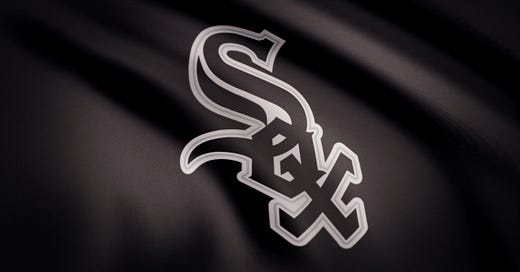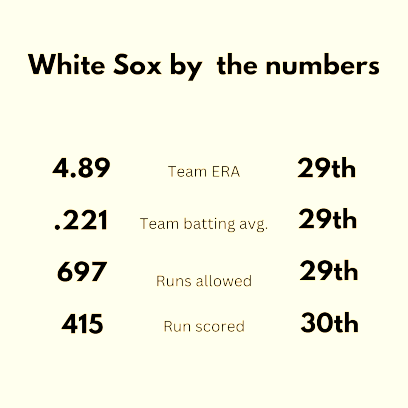White Sox pale in comparison to 1962 Mets
I'm hoping the Mets hold onto their modern record for the most losses in an MLB season. The 2024 White Sox are not only bad but dull.
HEART OF THE ORDER
The wrong side of history
The White Sox are challenging for the modern MLB record for futility, but they can’t match the ‘62 Mets’ flair.
Before the season opener in 1962, the Mets’ scheduled starting pitcher, Roger Craig, found himself trapped with several teammates for 30 minutes in an elevator at the Chase Hotel in St. Louis.
Craig later recalled that he was worried he might miss the expansion franchise’s first game. They were freed and got to the park on time . . . and the game was rained out.
This seems like an appropriate beginning to the season in which the Mets set the modern MLB record for losses in a season with 120.
Mets’ lore is filled with similar little gems from that disastrous first year.
Now that record is under threat from the Chicago White Sox. And I am rooting for the Mets’ mark to stand.
Sure, these White Sox are bad enough to eclipse the 1962 Mets, but those Mets were bad — and funny. Alas, these White Sox are merely bad.
Casey’s quip
The Mets were managed by Casey Stengel, who famously asked “Can’t anybody here play this game?” Jimmy Breslin took that quip for the title of his book on the 1962 Mets.
The Mets had Marv Throneberry. The best-known story about “Marvelous Marv” is that he was called out on what looked like a triple because he missed second base. When Stengel came out to argue, the umpire said, "Don't bother arguing, Casey, he missed first base, too."
Former Phillies star Richie Ashburn played center field. The Mets had a shortstop from Venezuela named Elio Chacon, who spoke little English. They kept colliding on pop flies.
Someone advised Ashburn to yell “Yo la tengo!” instead of “I got it.” It worked kind of.
The next time there was a short fly, Ashburn yelled “Yo la tengo!” and Chacon backed away. But left fielder Frank Thomas plowed into Ashburn. “What is a Yellow Tango?” Thomas supposedly asked.
In the 1980s, a New Jersey indie music band was familiar with Ashburn’s story and took “Yo La Tengo!” as the band’s name.
Ashburn was voted the Mets’ Most Valuable Player and given a boat. He said he docked it in New Jersey and it sank.
The Mets wanted Ashburn back for 1962, but he returned the contract they sent him unsigned. He decided to retire rather than pay for the Mets again and began working as an announcer for the Phillies.
Artificial intelligence, genuine stupidity
You can’t make this stuff. Well, maybe you can. Some cynics suspect the veracity of some of these Mets tales.
But with this year’s White Sox team, you would have to make stuff up. To wit, these gems:
The Record-Breaking Losing Streaks: Earlier this season, the White Sox set a new franchise record with 14 consecutive losses from May 22 to June 6. They then broke that record with an AL record-tying 21 straight losses from July 10 August 5. Fans joked that the team was trying to make losing an Olympic sport!
The Mascot’s Misadventures: During one particularly rough game, the White Sox mascot, Southpaw, tried to lighten the mood by attempting to catch a foul ball. Instead, he tripped over his own feet and ended up in the stands, much to the delight of the fans. It was a moment of levity in an otherwise challenging season.
The “Lucky” Socks: In an attempt to break their losing streak, the team decided to wear mismatched socks for a game, hoping it would bring some luck. Unfortunately, they still lost, but the sight of the players in their quirky socks gave everyone a good laugh.
The “Invisible” Ball: During a game against the Tigers, a White Sox outfielder lost sight of a fly ball in the sun and ended up running in circles trying to find it. The commentators joked that he was chasing an “invisible” ball, and the clip quickly went viral.
The “Fan Coach” Incident: In a desperate move, a fan jokingly offered to coach the team for a day on social media. Surprisingly, the White Sox invited him to spend a day with the team. While he didn’t actually coach, he got to hang out with the players and even gave a pep talk, which was a fun and memorable experience for everyone involved.
As far as I can tell, the only things true in those statements are the long losing streaks, and perhaps some fans joked about the White Sox making losing into an Olympic sport.
I was looking for a little color about the Pale Hose. When my research failed to yield anything, I turned to Microsoft Co-Pilot, which came up with that list.
Right now, relying on AI is like hiring a not-all-that-bright 15-year-old with an indifferent attitude
One weird moment
I came across one genuine and funny gaffe — with a Throneberry-esque feel.
In June, White Sox pitcher Garrett Crochet fielded a grounder hit by the Red Sox’s Jarren Duran and threw wildly to first base. Duran wound up at third.
The White Sox believed that Duran never touched first base. Crochet threw to first base to appeal the play.
Duran took off for home plate.
That distracted first baseman Andrew Vaughn. Instead of just catching the ball, he tried to catch the ball and throw it quickly to home. Of course, if Duran had missed first base, his steal of home would be a moot point.
But Vaughn didn’t catch the ball.
The throw was again off target, and Duran scored. Vaughn retrieved the ball and stepped on first base. This still would have been good enough for the appeal, even though Duran was in the dugout.
But umpire Alan Porter ruled Duran safe at first.
A replay clearly shows that Duran did, in fact, miss first base. The White Sox could have challenged the play on replay — and won, I presume — but they didn’t challenge it.
A few more plays like that and perhaps this 2024 White Sox team would be remembered as lovable losers.
Instead, Sox fans can’t wait to forget them.
Power of storytelling
So much of what is reported and written about baseball today is centered on numbers, But I can’t help but wonder if that’s why there’s not a trove of entertaining anecdotes about this bad White Sox team.
Throneberry committed 17 errors and had a fielding percentage of .981 in 1962. It would be 17 years before an MLB player equaled that fielding percentage.
Throneberry is remembered for being awkward. Lord knows, I love numbers. And while the numbers show Throneberry’s ineptitude with a glove, they do not capture the essence of Marvelous Marv — not in the way the story of Marv missing first and second bases on a would-be triple does.
Breslin’s book on the Mets is still available in paperback. I was looking on Amazon and reading comments. The book and, more importantly, the team still are much beloved.
It’s similar to another bad expansion team — the 1969 Seattle Pilots. Unlike the 1962 Mets, the Pilots were largely unloved during their one-season existence in the Pacific Northwest (they relocated to Milwaukee). But they are the subject of Jim Bouton’s tell-all book “Ball Four,” and thus rescued from obscurity.
The power of story-telling can transcend stats and highlight clips, as wonderful as they are.
BONUS FRAMES
Baseball connections: A surreal journey from the shortest player to one of the tallest
In the 1990s, someone noticed that actor Kevin Bacon had worked with wide range of movie people. There was a sociology theory that was popular at the time about how everyone was connected within six degrees of each other.
This was mashed into a party game called “The Six Degrees of Kevin Bacon.” I liked the idea, but I am not a big movie guy. And nobody wanted to play “The Six Degrees of Tony Gwynn.”
Well, I have my substack now. So I have come up with Baseball Connections.
Here is the idea. The degrees don’t matter. On one end or the other has to be a baseball figure. There has to be some documentation.
Being teammates is enough. Playing on opposite teams is enough.
Sitting in the stands in a game where someone played is not enough. Thus, Willie Mays and I have no direct connection.
In some cases, the documentation will be my recollection of meeting someone.
Finally, the journey is what’s important.
On Aug. 19, 1951, Eddie Gaedel, who was 3 feet, 7 inches tall, was sent to the plate to pinch hit for the St. Louis Browns. Gaedel drew a walk and was replaced by a pinch runner.
This was a publicity stunt dreamed up by Browns owner Bill Veeck Jr.
Veeck had previously owned the Cleveland Indians, now known as the Guardians. Under his stewardship, the Indians won the World Series in 1948, the franchise’s most recent World Series championship. While running the Indians, Veeck rubbed shoulders with entertainment types such as Mitzi Green, Gene Sheldon, and Skitch Henderson.
Veeck often flew to Chicago or New York late at night to party when some of his friends had gigs there. Then he’d fly back to Cleveland in the morning, he wrote in his best-selling autobiography “Veeck as in Wreck.” By his admission, Veeck didn’t sleep much during his Cleveland years.
Elsa Maxwell, a gossip columnist and high society party maven, visited Cleveland in 1948 and got caught up in the excitement of the Indians’ pennant run and World Series win. She became a friend of Veeck’s.
In February of 1949, Maxwell threw a party in Bill Veeck Jr.’s honor in New York City. Among the attendees was Salvadore Dali, the surreal artist.
Dali supposedly told Veeck “I don’t know much about your business.”
“Neither do I,” Veeck supposedly replied.
In 1973, Dali invited rock star Alice Cooper to New York. They were big fans of each other’s work. Dali created a “3D holographic sculpture of Alice Cooper’s brain.”
Cooper is a Phoenix boy (Cortez High School, Class of 1966). When the D-backs started up, Cooper opened a restaurant and bar near the ballpark called Cooper’s Town. One of his co-owners was Randy Johnson, the pitcher and future professional photographer.
The restaurant had a dish named after the 6-foot-10 Johnson, a hot dog called the Big Unit (Johnson’s nickname).
More help on the way? Orioles promote 19-year-old to Triple-A
The Orioles promoted catcher Samuel Basallo, 19, to Triple-A, a sign that Orioles, who have a core of promising young players, have more help on the way. Assuming Basallo gets 25 at-bats with Norfolk, he will be the sixth top prospect since 2006 to reach Triple-A by his age-19 season and get that many at-bats, according to FarnGraph’s reckoning.
The most recent one was infielder Jackson Holliday, also with the Orioles.
Getting to the majors by your early 20s is a good sign of future MLB stardom. Think Willie Mays, Mickey Mantle, Ken Griffey Jr., Alex Rodriguez, Albert Pujols, Fernando Valenzuela, Miguel Cabrera, Bryce Harper, and Mike Trout.




